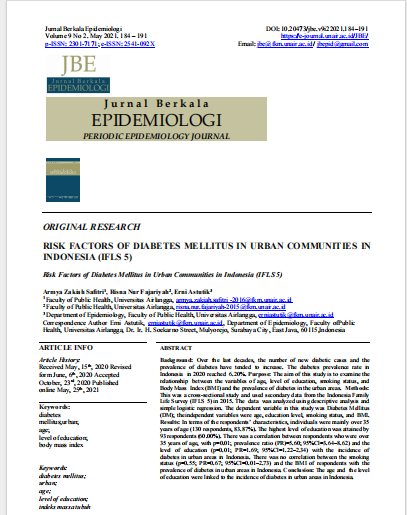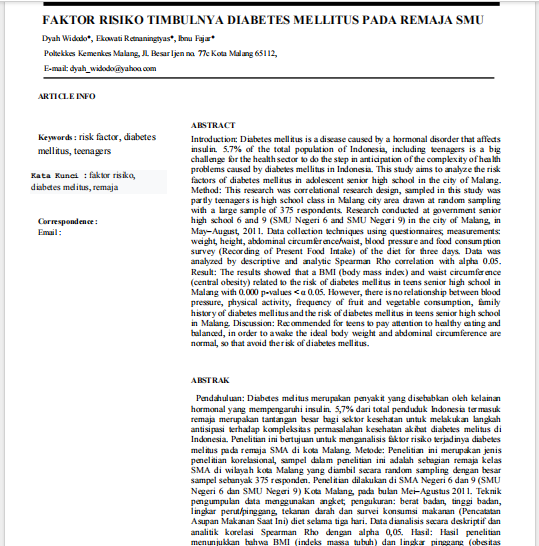RISK FACTORS OF DIABETES MELLITUS IN URBAN COMMUNITIES IN INDONESIA (IFLS 5)

Background:
Over the last decades, the number of new diabetic cases and the prevalence of diabetes have tended to increase. The diabetes prevalence rate in Indonesia in 2020 reached 6.20%. Purpose: The aim of this study is to examine the relationship between the variables of age, level of education, smoking status, and Body Mass Index (BMI) and the prevalence of diabetes in the urban areas. Methods: This was a cross-sectional study and used secondary data from the Indonesia Family Life Survey (IFLS 5) in 2015. The data was analyzed using descriptive analysis and simple logistic regression. The dependent variable in this study was Diabetes Mellitus (DM); theindependent variables were age, education level, smoking status, and BMI.
Results
In terms of the respondents’ characteristics, individuals were mainly over 35 years of age (130 respondents, 83.87%). The highest level of education was attained by 93 respondents (60.00%). There was a correlation between respondents who were over 35 years of age, with p=0.01; prevalence ratio (PR)=5.60; 95%Cl=3.64–8.62) and the level of education (p=0.01; PR=1.69; 95%Cl=1.22–2.34) with the incidence of diabetes in urban areas in Indonesia. There was no correlation between the smoking status (p=0.55; PR=0.67; 95%Cl=0.01–2.73) and the BMI of respondents with the prevalence of diabetes in urban areas in Indonesia. Conclusion: The age and the level of education were linked to the incidence of diabetes in urban areas in Indonesia.
Studi Prevalensi Resiko Diabetes Melitus Pada Remaja Usia 15-20 Tahun Di Pekanbaru
ABSTRACT
Over time, even the most sophisticated, memory packed computer can begin Worldwide number of adolescents diagnosed with diabetes mellitus has increased every year means that a prevention to reduce the prevalence of diabetes mellitus is required. The aim of this study was to determine the prevalence of diabetes mellitus risk in adolescents in Sidoarjo city, East Java and Diabetes Mellitus risk factors. Total population used in this study is composed by 150 men and women aged 15–20 years who reside in various locations in Sidoarjo city. The obtained data were analyzed descriptively with cross-sectional design. The results showed the prevalence of diabetes risk in adolescents in Sidoarjo is about 42% with average glucose levels 104.35 ± 13.01 mg/dl. The prevalence of non-diabetes mellitus in adolescents is 58% with the average glucose 79.26 ± 7.01 mg/dl. The risk factor which lead to high risk of diabetes mellitus is fast-food consumption (71%), soft drink consumption (31%) and smoking (5%).

FAKTOR RISIKO TIMBULNYA DIABETES MELLITUS PADA REMAJA SMU

Abstract
Introduction: Diabetes mellitus is a disease caused by a hormonal disorder that affects insulin. 5.7% of the total population of Indonesia, including teenagers is a big challenge for the health sector to do the step in anticipation of the complexity of health problems caused by diabetes mellitus in Indonesia. This study aims to analyze the risk factors of diabetes mellitus in adolescent senior high school in the city of Malang. Method: This research was correlational research design, sampled in this study was partly teenagers is high school class in Malang city area drawn at random sampling with a large sample of 375 respondents. Research conducted at government senior high school 6 and 9 (SMU Negeri 6 and SMU Negeri 9) in the city of Malang, in May–August, 2011. Data collection techniques using questionnaires; measurements: weight, height, abdominal circumference/waist, blood pressure and food consumption survey (Recording of Present Food Intake) of the diet for three days. Data was analyzed by descriptive and analytic Spearman Rho correlation with alpha 0.05. Result: The results showed that a BMI (body mass index) and waist circumference (central obesity) related to the risk of diabetes mellitus in teens senior high school in Malang with 0.000 p-values < α 0.05. However, there is no relationship between blood pressure, physical activity, frequency of fruit and vegetable consumption, family history of diabetes mellitus and the risk of diabetes mellitus in teens senior high school in Malang. Discussion: Recommended for teens to pay attention to healthy eating and balanced, in order to awake the ideal body weight and abdominal circumference are normal, so that avoid the risk of diabetes mellitus..
Block Quotes
“Diabetes is a silent storm, brewing in the body, affecting millions with its relentless grip. Yet, within each diabetic heart, resilience and strength beat in defiance.”
